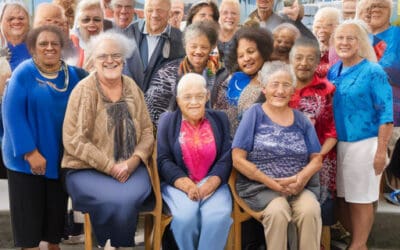In-Home Living Care’s Future
Technological advances, demographic changes, aging, and family preferences change living care. In-home living care services, formerly a last resort or temporary solution, are now desired by many. This change affects care delivery, experience, and perception.

Technology drives much of this transformation. Telemedicine, remote monitoring, and smart home gadgets make aging in place safer and more accessible for elders. Telemedicine allows doctors to consult and advise patients remotely, decreasing hospital visits. This benefits chronically ill patients who need regular monitoring yet prefer home comfort. Wearable health trackers and home sensors allow caregivers to monitor patients’ vital signs and everyday activities in real-time and alert them to any difficulties. These devices improve care and give families peace of mind that their loved ones are being monitored.
Smart home technologies also transform in-home living care services. Voice-activated assistants, automatic lighting, and intelligent security systems can make seniors’ homes safer and more convenient. For instance, Amazon’s Alexa and Google Home can help seniors manage their daily routines, set medicine reminders, and make emergency calls. Automated lighting systems help reduce fall risk by keeping homes well-lit, especially at night. Smart locks and surveillance cameras help caregivers protect their clients.
Demographic shifts are also shaping in-home living care. The worldwide elderly population is predicted to double by 2050 at an unprecedented rate, driving demand for effective, elderly-specific living care services. Seniors are more active and tech-savvy and demand a better life than earlier generations. They desire care options that let them be independent, engaged in their communities, and pursue their hobbies.
These needs are prompting in-home living care providers to go holistic. This strategy addresses elders’ emotional, social, and psychological well-being and medical issues. Care plans are increasingly individualized to foster health and happiness in a supportive and nurturing setting. Many providers now offer companionship services, which involve caregivers talking and doing things with seniors to reduce loneliness and despair.
Holistic care requires social connection, and technology is again crucial. Social media, video calling, and virtual reality are helping seniors remain in touch with loved ones and socialize even when alone. Thanks to virtual reality, seniors can now explore the world from home. Virtual museum tours, concerts, and group workouts can improve their quality of life.
Another fascinating development is in-home living care using AI. AI can help caretakers with scheduling, medication management, and predictive analytics to spot health issues before they become urgent. AI systems can discover trends and anomalies in remote monitoring device data, warning of heart attacks and strokes. Senior health can improve with timely interventions and this proactive strategy.
Virtual caregivers can communicate with seniors, send reminders, and provide companionship using AI. Virtual caregivers are very helpful for singles and individuals without human caretakers. They can complement care and provide extra support when human caregivers are unavailable, but they cannot replace them.
The future of in-home living care includes more caregiver training and support. The demand for these services increases the need for experienced, empathetic caregivers who can provide high-quality care. Training programs are being improved to teach caregivers how to use sophisticated technologies, recognize senior needs, and provide holistic care. Counseling and respite services are also offered to help caregivers cope with their physical and mental workloads.

Multigenerational Living Care
Living care is changing as families find new ways to care for generations. Multigenerational living meets the practical and emotional demands of elderly parents, adult children, and grandkids. Such households bring distinct problems and opportunities, transforming care delivery and experience.
Multigenerational living care solutions foster growth for all ages. The benefits go beyond money savings to emotional enrichment and more excellent family relationships. Living together allows families to share resources, alleviate caring, and create a sense of community and connection that single-generation households lack. This system lets older persons be independent while receiving support.
Multigenerational living requires good architecture. Homes are being equipped with flexible areas that can adjust to shifting needs. This could mean establishing private living spaces, providing accessibility facilities for aging family members, or adding communal spaces that foster contact. These clever designs allow babies and elders to cohabit safely and happily.
Technology improves multigenerational living care, too. Voice-activated assistants, security systems, and health monitoring tools connect independence and support. Wearable gadgets can monitor vital signs and notify caretakers of potential health risks for prompt treatment. Despite distance, video calling and social networking keep families united and supported.
Living with several generations has tremendous emotional benefits. Isolation and loneliness can harm older individuals’ health. A multigenerational household gives continual companionship, lowering negative sentiments and improving mental health. However, elders’ wisdom and life experience help younger family members appreciate their history and traditions.
Family caregiving is more equitably distributed in multigenerational households. This shared responsibility reduces family member burnout and improves care. It also allows family members to care for older people continuously without compromising their dignity or freedom.
Multigenerational living can be smart financially. Senior living and long-term care are expensive. Living together lets families save on housing and utilities and better devote finances to healthcare and other essentials. This collaborative financial approach can significantly reduce family financial stress.
Multigenerational living care solutions may rise due to culture. Many cultures have multiple generations living together, and more families are adopting this practice globally. These societal changes reflect a rising awareness of multigenerational living’s benefits, from stronger family relationships to better care. It also emphasizes the value of family traditions and values, which can provide strength and continuity.
Support networks and community resources are essential for multigenerational living care. Local governments and organizations realize that tax incentives, affordable housing, and caregiver support services are needed to help these households. These strategies can ease multigenerational living and ensure families have the necessary resources.

Successful multigenerational living requires caregiver education and training. Family members need knowledge and abilities to care for aging relatives. Understanding their needs is key to helping older persons manage chronic diseases, provide emotional support, and navigate the healthcare system. Using caregiver training programs’ insights and tactics, families can provide high-quality care at home.
Intergenerational activities and events can enhance multigenerational life. These programs support multigenerational family activities, including recreation and community service. These conversations build respect and understanding between generations and create lasting memories. They allow younger family members to learn life skills and viewpoints from their elders.
Success requires flexibility and agility in multigenerational living care solutions. As family dynamics and requirements change, households must adapt their living arrangements and caregiving practices. This may require changing the home setting, requesting more support, or reassessing caregiving duties. Families may manage intergenerational living and meet everyone’s requirements by being flexible and open to change.



